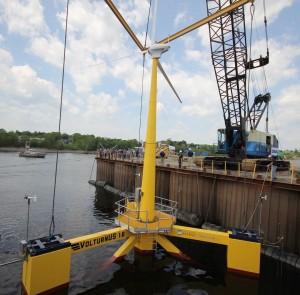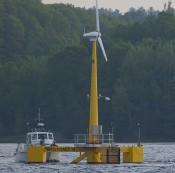

The first floating wind turbine in U.S. history took the plunge in Brewer, Maine, last week. Then it was towed 30 miles down the Penobscot River and out to sea, to be connected to the grid. Since Maine has some of the strongest winds on the East Coast, every second 600,000 pounds of force will pour through the turbine blades, according to Dr. Habib Dagher, Director of the University of Maine's Advanced Structures and Composites Center, where he coaxed the patent-pending turbine into existence. The goal for Dagher is to reduce the cost of offshore wind energy. "In Europe offshore wind costs twice as much as wind energy harnessed on land. The purpose of our turbine, the VolturnUS, is to bring that cost down. Our shared goal with the DOE is to get the cost to ten cents a kilowatt-hour by 2020. It's key to the whole project," said Dagher. A CBS report captured the hoopla of the day's activities:
Students create a NIMBY-proof wind turbine
Floating turbines are seen as a next step in offshore wind development. Standard offshore turbines are usually installed in waters less than 30 meters deep, but deeper water, made accessible with floating turbines, offers better wind and fewer public relations problems - think CapeWind. Traditional offshore turbines also have their bases driven into the seafloor, which is far more expensive than a floating turbine's anchoring system. And, if a floating turbine needs repairs, it can be towed back to shore, where the work is less costly. Designed by University of Maine engineering students in the Offshore Wind Program, this floating turbine uses materials that cut costs while maintaining high performance, according to the DOE press release. For example, the Maine floating wind turbine sits on a tower that substitutes lighter-weight composites for steel, supported by a semi-submersible platform made with lower cost concrete. (A short video about the public unveiling of the concrete base.) While this small prototype only puts out 20 kilowatts, the amount of power used by a street of suburban houses on a hot summer day, if successful, researchers will later deploy a huge 6-megawatt model 20 miles offshore, well beyond the horizon, solving the NIMBY problems that have hindered the development of the U.S. offshore wind industry. "You will not be able to see them, you will not be able to hear them, so nobody will know they're there, but they're out there creating clean, renewable energy to power our state," said Dagher. He elaborates in an October 2011 TEDXtalk:
Then, in a best case scenario, by 2030 the university hopes to install a farm of 170 6-megawatt turbines that would produce 5 gigawatts of electricity, roughly equal to the energy from five nuclear power plants.University-led innovation
Several years ago, with funding from the DOE, the National Science Foundation and the Maine Technology Institute, the Advanced Structures and Composites Center launched the DeepCwind Consortium, charged by former Secretary of the Energy Chu to lead the nation in floating offshore wind technology. To achieve this goal, Dagher's team had to create a new design. First, they extended the turbine's lifespan. The low cost solution: concrete. "In Europe offshore wind turbines have a life of about twenty to thirty years. The VolturnUS has a hundred year life expectancy. That's why we developed the concrete base," said Dagher. Then he targeted efficiency. The first turbine will also be used to test new control systems and sensors (see video)."It will be able to sense the environment around it," Dagher said. Based on wind speed and direction, the turbine automatically turns and adjusts the angle of its blades to attain the most efficient use of the wind or avoid its full force if it grows too strong.

The offshore advantage
Floating turbines have a big advantage over land-based machines, according to Dagher. Onshore wind machines produce most of their energy at night, when it is least useful to utilities, but this new turbine will catch the predictable, strong winds that come up every summer afternoon, when the sun heats the land more than the sea. While two demo floating projects have launched in Europe, one by Energias de Portugal and Principle Power off Portugal and the world's first, in 2009, Statoil's Hywind, they both rely on heavier, more expensive steel technology. Looking into the future, Dagher sees Maine's more cost-effective floating wind farm creating a new manufacturing base while driving wind energy prices down to about 10 cents per kilowatt hour by 2020, a win-win for the state and the Northeast receiving exported energy.


